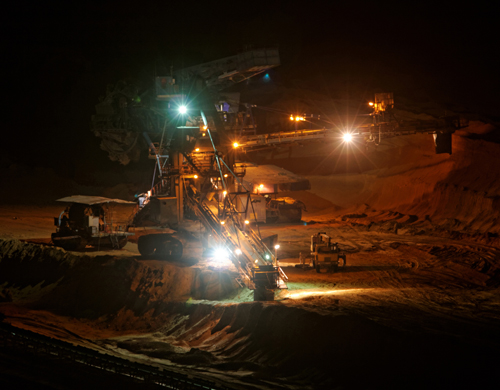
Having been in production since late 2005, it took less than five years for Goldcorp’s Marlin Mine to produce its one-millionth ounce of gold. Located in the western highlands of Guatemala, 300 kilometres northwest of Guatemala City in the municipality of San Miguel Ixtahuacan, in an area boasting elevations ranging from 1,800 to 2,300 metres above sea level, Marlin has operated as both an open pit and underground mine, and continues to generate significant cash flow.
Marlin Mine was originally discovered in 1998 by two Guatemalan geologists. Acquired in July 2002 by Canadian Company Glamis Gold, it was they who, in conducting an exploration study, determined that the mine held a projected 1.4 million ounces of gold.
On 27 November 2003, the Ministry of Energy and Mines of Guatemala issued a licence for the development and operation of the Marlin project and following the successful completion of the construction phase in the third quarter of 2005, the mine began producing gold and silver before the turn of the year.
In the time between 2003 and 2006 approximately $300 million was invested into the operator’s exploration activities and overall preparations for exploitation. It was then in 2009 that Goldcorp invested an additional $69 million into the operation, with a similar figure being ploughed into the business in 2010. Such was Goldcorp’s commitment to the long-term success of the project that it remains on course to have invested a further $150 million into Marlin Mine by the end of 2014.
Lying within a highly prospective land package of approximately 100,000 hectares that encompass the main deposit and various important vein structures and mineralised zones, the Marlin site hosts four major lithologic units, those being pyroclastic deposits, marlin andesites, tertiary volcaniclastic sequence and porphyric dykes.
Marlin was the first gold mine of significant size in Guatemala and because of this Goldcorp made it a matter of great important to build lasting partnerships with communities surrounding the mine site. To this day the company continues to have a positive impact on the lives of families in the area through the creation of increased health, economic, educational and social opportunities. Furthermore, of the mine’s 1,905 workers, approximately 98 percent of these are Guatemalan residents.
These employees operate each day knowing they are protected by Marlin’s stringent health, safety and environment rules and standards. Indeed, the safety culture one will find present at the mine has benefited hugely from countless successful safety initiatives that have been implemented throughout the years, including daily and weekly safety briefings, monthly inspections and ongoing training programmes.
The mine also operates in full compliance with the environmental standards and regulations of Guatemala and to the mining industry guidelines as set out by the World Bank. Furthermore, Marlin adheres to the internal Goldcorp standards in order to ensure that the highest level of environmental stewardship is achieved. Marlin’s Environmental Management System (EMS) is designed to promote continuous improvement in the environmental management of the operation. The EMS concentrates on four phases, those being policy and planning, implementation, evaluation, and review and Improvement.
Of equal significance is the fact that Marlin holds the distinction of being the first mine in Central America to become fully certified under the International Cyanide Management Code, which is recognised as the international benchmark for transporting, storing and using cyanide.
However, long before any Goldcorp mine commences with production the company will have already put plans in place for its eventual closure and the subsequent reclamation of the land. The Marlin Closure Plan for the open pit and waste rock storage facility was approved by the Guatemalan Ministry of Environment and Natural Resources (MARN) in October 2012.
Goldcorp’s wholly owned subsidiary, Montana Exploradora de Guatemala, submitted the corresponding compliance bond to the MARN in the amount $28 million on October 16, 2012. The closure compliance bond amount established with MARN will be adjusted according to actual conditions and as subsequent sections of the closure plan are updated, reviewed and approved by the MARN.
Subsequent sections of the closure plane will be updated as required by the MARN. The geochemical, hydrological and geotechnical assessments required for the Tailings Impoundment Closure Plan was conducted during 2013, and a final plan is expected to be submitted to the authorities before the end of 2014.
Another part of Marlin’s internal structure is its Sustainable Development department. It is this area of the business which provides resources and funds for community development initiatives in communities near the operation and along the access road to the mine through its Organizational Development Unit.
Each project is designed, selected and implemented in conjunction with community leaders and members. The Sierra Madre Foundation (SMF) is a Guatemalan foundation, funded by Goldcorp, which was formed in an effort to contribute to the development of neighbouring communities. Its mission is to assist with the planning and implementation of sustainable, community-based development and capacity building programs in San Miguel Ixtahuacán and Sipacapa.
In early 2012, open pit operations at Marlin ceased when the mining of the final, higher-grade portion of the pit was completed. Today the mine is an underground operation only. Underground operations at the site employ mechanised cut-and-fill and long hole stoping mining, with underground loading equipment feeding haul trucks that transport the ore to the surface via ramps. Production from underground operations is roughly 2,000 tonnes of ore per day. This ore is processed in a conventional crushing, grinding and milling circuit. Marlin also has a tailing storage facility, a waste rock storage area and various ancillary installations.
Despite open pit operations coming to an end, successful exploration activities in the area surrounding the pit indicate the potential for extending the life of the mine. The discovery of a bonanza grade vein, the Delmy vein, which is located near the Marlin deposit and within the existing mining area, will contribute significantly to the mine’s future production.
Written by Will Daynes, research by Candice Nice



 Goldcorp-MarlinMine-Americas-Mining-Apr14-Bro-s.pdf
Goldcorp-MarlinMine-Americas-Mining-Apr14-Bro-s.pdf









